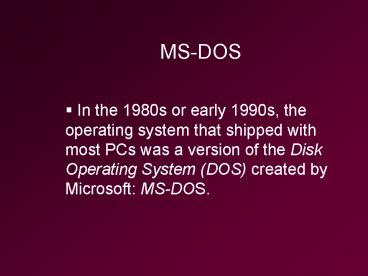MSDOS - PowerPoint PPT Presentation
1 / 16
Title:
MSDOS
Description:
MS-DOS ... In its day, it was easily the most popular operating system ... The boot disk drive. The console display and keyboard. The system's time-of-day clock ... – PowerPoint PPT presentation
Number of Views:5261
Avg rating:3.0/5.0
Title: MSDOS
1
MS-DOS
- In the 1980s or early 1990s, the operating
system that shipped with most PCs was a version
of the Disk Operating System (DOS) created by
Microsoft MS-DOS.
2
MS-DOS
- MS-DOS is a disk operating system for IBM
PCcompatible computers. - In its day, it was easily the most popular
operating system in the world. It also is the
basis from which Windows 9x derives its
under-lying organization.
3
MS-DOS
- As with any other operating system, its function
is to oversee the operation of the system by
providing support for executing programs,
controlling I/O devices, handling errors, and
providing the user interface.
4
MS-DOS
- MS-DOS is a disk-based, single-user, single-task
operating system. These qualities make it one of
the easiest disk operating systems to understand.
5
MS-DOS
- The main portions of MS-DOS are the IO.SYS,
MSDOS.SYS, and COMMAND.COM files. - IO.SYS and MSDOS.SYS are special, hidden system
files
6
MS-DOS
- The IO.SYS file moves the systems basic I/O
functions into memory and then implements the
MS-DOS default control programs, referred to as
device drivers, for various hardware components. - These include the following
- The boot disk drive
- The console display and keyboard
- The systems time-of-day clock
- The parallel and serial communications port
7
MS-DOS
- The MSDOS.SYS file provides default support
features for software applications. - These features include the following
- Memory management
- Character input and output
- Real-time clock access
- File and record management
- Execution of other programs
8
MS-DOS
- The COMMAND.COM command interpreter accepts
commands issued through the keyboard, or other
input device, and carries them out according to
the commands definition.
9
MS-DOS
- When DOS runs an application, COMMAND.COM finds
the program, loads it into memory, and then gives
it control of the system. When the program is
shut down, it passes control back to the command
interpreter.
10
MS-DOS
- The remainder of the operating system is
comprised of utility programs to carry out DOS
operations, such as formatting disks (FORMAT),
printing files (PRINT), and copying files (XCOPY).
11
Dos Commands
- MS-DOS Commands
- A command is the name of a special program that
makes your computer carry out a task. There are
two types of MS-DOS commands - internal and
external
12
Internal Dos Commands
- Internal commands are built into the operating
system as part of a file called COMMAND.COM (or,
on a 2000 or XP machine CMD.EXE) . They are
loaded into memory whenever you switch on your
computer. When you type an internal command,
MS-DOS performs it immediately.
13
External Dos Commands
- Files with extension COM or EXE are external
commands. Because these commands are files, they
are not built into the operating system ( these
are the commands that alter between versions of
MS-DOS) .
14
Internal DOS Commands
- DIR
- TYPE
- COPY
- REN
- MD
- CD
- CD..
- CD\
- DEL
- DATE
- TIME
- VER
- VOL
- CLS
- PROMPT
- CD
- RD
- EXIT
- COPY CON
15
External DOS Commands
- APPEND
- EDIT
- RESTORE
- ATTRIB
- LABEL
- BACKUP
- MODE
- SORT
- CHKDSK
- FIND
- DELTREE
- XCOPY
- REPLACE
- DISKCOPY
- SYS
- COMP
- FORMAT
16
(No Transcript)































